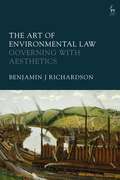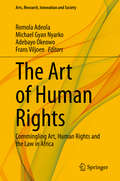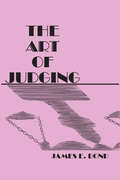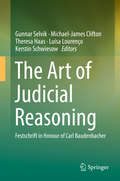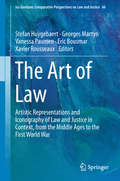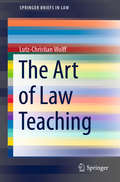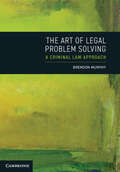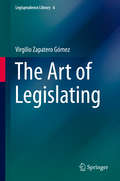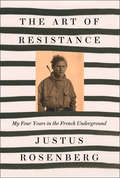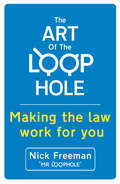- Table View
- List View
The Art of Environmental Law: Governing with Aesthetics
by Benjamin J RichardsonEnvironmental law has aesthetic dimensions. Aesthetic values have shaped the making of environmental law, and in turn such law governs many of our nature-based sensory experiences. Aesthetics is also integral to understanding the very fabric of environmental law, in its institutions, procedures and discourses. The Art of Environmental Law, the first book of its kind, brings new insights into the importance of aesthetic issues in a variety of domains of environmental governance around the world, from climate change to biodiversity conservation. It also argues for aesthetics, and relatedly the arts, to be taken more seriously in the practice of environmental law so as to improve our emotional and ethical capacities to address the upheavals of the Anthropocene.
The Art of Environmental Law: Governing with Aesthetics
by Benjamin J RichardsonEnvironmental law has aesthetic dimensions. Aesthetic values have shaped the making of environmental law, and in turn such law governs many of our nature-based sensory experiences. Aesthetics is also integral to understanding the very fabric of environmental law, in its institutions, procedures and discourses. The Art of Environmental Law, the first book of its kind, brings new insights into the importance of aesthetic issues in a variety of domains of environmental governance around the world, from climate change to biodiversity conservation. It also argues for aesthetics, and relatedly the arts, to be taken more seriously in the practice of environmental law so as to improve our emotional and ethical capacities to address the upheavals of the Anthropocene.
The Art of Human Rights: Commingling Art, Human Rights and the Law in Africa (Arts, Research, Innovation and Society)
by Romola Adeola Michael Gyan Nyarko Adebayo Okeowo Frans ViljoenThis book highlights the use of art in human rights, specifically within Africa. It advances an innovative pattern of thinking that explores the intersection between art and human rights law. In recent years, art has become an important tool for engagement on several human rights issues. In view of its potency, and yet potential to be a danger when misused, this book seeks to articulate the use of arts in the human rights discourse in its different forms. Chapters cover how music, photography, literature, photojournalism, soap opera, commemorations, sculpting and theatre can be used as an expression of human rights. This book demonstrates how arts have become a formidable expression of thoughts and a means of articulating reality in a form that simplifies truth and congregates resolve to advance change.
Art of Judging: Volume 8
by James. E BondThe single most important issue in American constitutional law is the role the Supreme Court should play in interpretation of the constitution. This issue has been a source of controversy since at least 1803, when Chief Justice John Marshall proclaimed that the Supreme Court could declare acts of Congress unconstitutional. But public attention has been refocused by the recent debate between Attorney General Edwin Meese and Supreme Court Justice William Brennan. The Attorney General admonished the Justices to confine themselves to strict construction of the Constitution-to apply the Constitution as the framers intended. Justice Brennan rejected this as errant and arrogant because the framers had certainly not thought about the specific problems facing the country today.
Art of Judging: Volume 8
by James. E BondThe single most important issue in American constitutional law is the role the Supreme Court should play in interpretation of the constitution. This issue has been a source of controversy since at least 1803, when Chief Justice John Marshall proclaimed that the Supreme Court could declare acts of Congress unconstitutional. But public attention has been refocused by the recent debate between Attorney General Edwin Meese and Supreme Court Justice William Brennan. The Attorney General admonished the Justices to confine themselves to strict construction of the Constitution-to apply the Constitution as the framers intended. Justice Brennan rejected this as errant and arrogant because the framers had certainly not thought about the specific problems facing the country today.
The Art of Judicial Reasoning: Festschrift in Honour of Carl Baudenbacher
by Gunnar Selvik Michael-James Clifton Theresa Haas Luísa Lourenço Kerstin SchwiesowThis book, formed as a series of essays in honour of Professor Carl Baudenbacher, addresses the very art of judicial reasoning, and features contributions from many of the foremost current or former national, supranational, or international judges. This unique volume is intended first and foremost for legal scholars, but its approachable style makes it readily accessible for students and for those with a general interest in the application of the law and justice in today’s multi-layered world. The collection of essays is rather more philosophical and reflective as opposed to doctrinal. Each contribution focuses on the nature and operation of justice, the independence of the judiciary, and on judicial style primarily from the perspective of the judges themselves. The book provides perspectives on what it means to be accountable and independent as a judge, the role of language and languages in the quest for justice, while other contributions acquaint readers with the some of the structures of courts themselves, or indeed question for whom judgments are written. Each chapter has been written by a presiding judge, or head of an institution and the book is divided into three parts: - Part I Art and Method- Part II Justice and the Judiciary- Part III Reasoning and Language(s)
The Art of Law: Artistic Representations and Iconography of Law and Justice in Context, from the Middle Ages to the First World War (Ius Gentium: Comparative Perspectives on Law and Justice #66)
by Stefan Huygebaert Georges Martyn Vanessa Paumen Eric Bousmar Xavier RousseauxThe contributions to this volume were written by historians, legal historians and art historians, each using his or her own methods and sources, but all concentrating on topics from the broad subject of historical legal iconography. How have the concepts of law and justice been represented in (public) art from the Late Middle Ages onwards? Justices and rulers had their courtrooms, but also churches, decorated with inspiring images. At first, the religious influence was enormous, but starting with the Early Modern Era, new symbols and allegories began appearing. Throughout history, art has been used to legitimise the act of judging, but artists have also satirised the law and the lawyers; architects and artisans have engaged in juridical and judicial projects and, in some criminal cases, convicts have even been sentenced to produce works of art. The book illustrates and contextualises the various interactions between law and justice on the one hand, and their artistic representations in paintings, statues, drawings, tapestries, prints and books on the other.
The Art of Law in Shakespeare
by Paul RaffieldThrough an examination of five plays by Shakespeare, Paul Raffield analyses the contiguous development of common law and poetic drama during the first decade of Jacobean rule. The broad premise of The Art of Law in Shakespeare is that the 'artificial reason' of law was a complex art form that shared the same rhetorical strategy as the plays of Shakespeare. Common law and Shakespearean drama of this period employed various aesthetic devices to capture the imagination and the emotional attachment of their respective audiences. Common law of the Jacobean era, as spoken in the law courts, learnt at the Inns of Court and recorded in the law reports, used imagery that would have been familiar to audiences of Shakespeare's plays. In its juridical form, English law was intrinsically dramatic, its adversarial mode of expression being founded on an agonistic model. Conversely, Shakespeare borrowed from the common law some of its most critical themes: justice, legitimacy, sovereignty, community, fairness, and (above all else) humanity. Each chapter investigates a particular aspect of the common law, seen through the lens of a specific play by Shakespeare. Topics include the unprecedented significance of rhetorical skills to the practice and learning of common law (Love's Labour's Lost); the early modern treason trial as exemplar of the theatre of law (Macbeth); the art of law as the legitimate distillation of the law of nature (The Winter's Tale); the efforts of common lawyers to create an image of nationhood from both classical and Judeo-Christian mythography (Cymbeline); and the theatrical device of the island as microcosm of the Jacobean state and the project of imperial expansion (The Tempest).
The Art of Law in Shakespeare
by Paul RaffieldThrough an examination of five plays by Shakespeare, Paul Raffield analyses the contiguous development of common law and poetic drama during the first decade of Jacobean rule. The broad premise of The Art of Law in Shakespeare is that the 'artificial reason' of law was a complex art form that shared the same rhetorical strategy as the plays of Shakespeare. Common law and Shakespearean drama of this period employed various aesthetic devices to capture the imagination and the emotional attachment of their respective audiences. Common law of the Jacobean era, as spoken in the law courts, learnt at the Inns of Court and recorded in the law reports, used imagery that would have been familiar to audiences of Shakespeare's plays. In its juridical form, English law was intrinsically dramatic, its adversarial mode of expression being founded on an agonistic model. Conversely, Shakespeare borrowed from the common law some of its most critical themes: justice, legitimacy, sovereignty, community, fairness, and (above all else) humanity. Each chapter investigates a particular aspect of the common law, seen through the lens of a specific play by Shakespeare. Topics include the unprecedented significance of rhetorical skills to the practice and learning of common law (Love's Labour's Lost); the early modern treason trial as exemplar of the theatre of law (Macbeth); the art of law as the legitimate distillation of the law of nature (The Winter's Tale); the efforts of common lawyers to create an image of nationhood from both classical and Judeo-Christian mythography (Cymbeline); and the theatrical device of the island as microcosm of the Jacobean state and the project of imperial expansion (The Tempest).
The Art of Law Teaching (SpringerBriefs in Law)
by Lutz-Christian WolffWritten by an award-winning professor with over 25 years of experience, this book explains comprehensively the different facets of law teaching from the law teacher’s perspective. It uniquely covers numerous topics which have been ignored by the legal education literature so far, but which are of immense importance for the success of law students, law schools and—last but not least—the day-to-day work of law teachers themselves. These topics include the goals of law teaching, the factors that lead to successful law teaching, special characteristics of good law teachers, different ways of preparing for in-class success, face-to-face versus online teaching, the in-class teaching experience, assessments, teaching evaluations, the design of new courses and programmes, the teacher–student and the teacher–teacher relationship, the importance of teaching administration as well as the future of law teaching in the digital age. The author approaches various themes from the viewpoint of his own experience. He tells his very personal stories of classroom success and failure, of enthusiasm, fun and disappointments when dealing with law students, of accomplishments and frustrations when considering learning outcomes and of surprises when dealing with red tape. He thus allows the readership to grasp different aspects of law teaching in a very hands-own way and facilitates the understanding of the underlying often rather complex human-to-human relationships. This book should be in the bookshelf of any law teacher. As it covers a wide spectrum of so far unexplored legal education issues, it is also an invaluable source at the start of a law teaching career, but also for established law teachers who wish to reflect on their own teaching approaches. A rich body of cross-references to the existing literature makes the book a powerful tool for research on any aspect of legal education. Last but not least, the author’s ironic sense of himself and of the law teacher profession makes the book a very entertaining read for anybody who always wanted to know what law teaching really is (and is not) about.
The Art of Legal Problem Solving: A Criminal Law Approach
by null Brendon MurphyThe Art of Legal Problem Solving: A Criminal Law Approach is a sophisticated skills book designed to help students develop the problem-solving techniques necessary for their legal careers. This succinct yet comprehensive book provides the perfect mix of general instruction and specific examples to encourage students to think about problems both in depth and broadly. It follows a clear roadmap presented in a logical progression, beginning with the fundamentals, fact finding and statutory interpretation before turning to the advanced areas of analysing and writing answers to problem questions. While written primarily for criminal law students, the skills imparted are generic and can be applied equally in any area of the law and in any jurisdiction. The Art of Legal Problem Solving is an indispensable work for law students who want to not only improve their problem-solving skills but master them.
The Art of Legal Problem Solving: A Criminal Law Approach
by null Brendon MurphyThe Art of Legal Problem Solving: A Criminal Law Approach is a sophisticated skills book designed to help students develop the problem-solving techniques necessary for their legal careers. This succinct yet comprehensive book provides the perfect mix of general instruction and specific examples to encourage students to think about problems both in depth and broadly. It follows a clear roadmap presented in a logical progression, beginning with the fundamentals, fact finding and statutory interpretation before turning to the advanced areas of analysing and writing answers to problem questions. While written primarily for criminal law students, the skills imparted are generic and can be applied equally in any area of the law and in any jurisdiction. The Art of Legal Problem Solving is an indispensable work for law students who want to not only improve their problem-solving skills but master them.
The Art of Legislating (Legisprudence Library #6)
by Virgilio Zapatero GómezAny contemporary state presents itself as committed to the “rule of law”, and this notion is perhaps the most powerful political ideal within the current global discourse on legal and political institutions. Despite being a contested concept, the rule of law is generally recognised as meaning that government is bound in all its actions by fixed and public rules, and that these rules respect certain formal requirements and are enforced by an independent judiciary. This book focuses on formal legality and the question of how to achieve good laws—a topic that was famously addressed by the 18th century enlightened thinkers, but also by prominent legal scholars of our time. Historically, the canon of “good legislation” demanded generality, publicity and accessibility, and comprehensibility of laws; non-retroactivity; consistency; the possibility of complying with legal obligations and prohibitions; stability; and congruency between enacted laws and their application. All these are valuable ideals that should not be abandoned in today’s legal systems, particularly in view of the silent revolution that is transforming our legality-based “states of law” into jurisdictional states. Such ideals are still worth pursuing for those who believe in representative democracy, in the rule of law and in the dignity of legislation. The idea for the book stemmed from the author’s parliamentary and governmental experience; he was responsible for the Government of Spain’s legislative co-ordination from 1982 to 1993, which were years of intensive legislative production. The more than five hundred laws (and thousands of decrees) elaborated in this period profoundly changed all sectors of the legal order inherited from Franco’s dictatorship, and laid the foundations of a new social and democratic system. For an academic, this was an exciting experience, which offered a unique opportunity to put the theory of legislation to the test. Reflecting and elaborating on this experience, the book not only increases scholarly awareness of how laws are made, but above all, improves the quality of legislation and as a result the rule of law.
The Art of Living Well: Moral Experience and Virtue Ethics
by Paul van TongerenThe first English translation of the prize winning Dutch title Leven is Een Kunst, this is a fascinating book, in which prominent ethicist and Nietzsche specialist Paul van Tongeren creates a contemporary version of classical virtue ethics. Virtue ethics goes right back to the moral philosophy of Aristotle and some could argue is nothing new. However, Van Tongeren demonstrates how the original Artistotlean approach been extended and corrected throughout the centuries by the Stoics, Christianity, and Nietzsche and how we now need new kind of ethics - a creative, artful ethics that takes seriously the desire to 'live well'. Acting as both a brilliantly clear introduction to virtue ethics and moral philosophy and a serious work of original philosophy, this book connects philosophy with real lived experience and tackles, head-on, the perennial philosophical question: how do we live well?
The Art of Living Well: Moral Experience and Virtue Ethics
by Paul van TongerenThe first English translation of the prize winning Dutch title Leven is Een Kunst, this is a fascinating book, in which prominent ethicist and Nietzsche specialist Paul van Tongeren creates a contemporary version of classical virtue ethics. Virtue ethics goes right back to the moral philosophy of Aristotle and some could argue is nothing new. However, Van Tongeren demonstrates how the original Artistotlean approach been extended and corrected throughout the centuries by the Stoics, Christianity, and Nietzsche and how we now need new kind of ethics - a creative, artful ethics that takes seriously the desire to 'live well'. Acting as both a brilliantly clear introduction to virtue ethics and moral philosophy and a serious work of original philosophy, this book connects philosophy with real lived experience and tackles, head-on, the perennial philosophical question: how do we live well?
The Art of Mooting: Theories, Principles and Practice
by Mark Thomas Lucy CradduckAdvocacy skills, which are learnt in the moot court, as a precursor to the effective communication of persuasive legal argument, are essential for those seeking a career in law. The skills associated with successful mooting, cover the entire range of the domains of human activity: intellectual, physical and emotional. This informative book examines the theories relevant to the development of skills necessary for effective participation in competition moots. By consideration of underlying theories, Mark Thomas and Lucy Cradduck develop unique models of the skills of the cognitive, psychomotor and affective domains and effective team dynamics, emphasising the importance of written submissions. The authors use this analysis to develop a unique integrated model that informs the process of coaching moot teams according to reliable principles. The Art of Mooting distils the theories and principles that support successful moot performances, grounding these in practical examples of how a mooter’s skills may be developed and improved. It is an essential guide for moot coaches, law and advocacy students and academics seeking to improve their skills, and new and existing practitioners.
The Art of Post-Dictatorship: Ethics and Aesthetics in Transitional Argentina
by Vikki BellSince the end of the last dictatorship in 1983, Argentina’s visual artists and art-activists have been central to campaigns to demand the criminal prosecution of those initially granted amnesty and to a variety of commemorative projects. In The Art of Post-Dictatorship: Ethics and Aesthetics in Transitional Argentina Vikki Bell examines this involvement and intervention. She argues that the problematics that arise within the aesthetic realm cannot be understood solely through an art-historical approach; instead, they must be understood as a constitutive part of a broader collective endeavour. In this sense, the ‘art’ of post-dictatorship is not something that belongs to art or the artists themselves, but is about how the subjectivities and imaginations of new generations are constituted and entwined with questions of response, ethics and justice. It concerns how people align themselves between the past and the future. This book will be an invaluable resource for those studying the law, politics, art and sociology of contemporary Argentina as well as those concerned more widely with transitional justice and the politics of memory.
The Art of Post-Dictatorship: Ethics and Aesthetics in Transitional Argentina
by Vikki BellSince the end of the last dictatorship in 1983, Argentina’s visual artists and art-activists have been central to campaigns to demand the criminal prosecution of those initially granted amnesty and to a variety of commemorative projects. In The Art of Post-Dictatorship: Ethics and Aesthetics in Transitional Argentina Vikki Bell examines this involvement and intervention. She argues that the problematics that arise within the aesthetic realm cannot be understood solely through an art-historical approach; instead, they must be understood as a constitutive part of a broader collective endeavour. In this sense, the ‘art’ of post-dictatorship is not something that belongs to art or the artists themselves, but is about how the subjectivities and imaginations of new generations are constituted and entwined with questions of response, ethics and justice. It concerns how people align themselves between the past and the future. This book will be an invaluable resource for those studying the law, politics, art and sociology of contemporary Argentina as well as those concerned more widely with transitional justice and the politics of memory.
The Art of Resistance: My Four Years In The French Underground: A Memoir
by Justus RosenbergA gripping memoir written by a 96-year-old Jewish Holocaust survivor about his escape from Nazi-occupied Poland in the 1930's and his adventures with the French Resistance during World War II
The Art of Revolt: Snowden, Assange, Manning
by Geoffroy de LagasnerieEdward Snowden, Julian Assange, and Chelsea Manning are key figures in the struggles playing out in our democracies over internet use, state secrets, and mass surveillance in the age of terror. When not decried as traitors, they are seen as whistle-blowers whose crucial revelations are meant to denounce a problem or correct an injustice. Yet, for Geoffroy de Lagasnerie, they are much more than that. Snowden, Assange, and Manning are exemplars who have reinvented an art of revolt. Consciously or not, they have inaugurated a new form of political action and a new identity for the political subject. Anonymity as practiced by WikiLeaks and the flight and requests for asylum of Snowden and Assange break with traditional forms of democratic protest. Yet we can hardly dismiss them as acts of cowardice. Rather, as Lagasnerie suggests, such solitary choices challenge us to question classic modes of collective action, calling old conceptions of the state and citizenship into question and inviting us to reformulate the language of critical philosophy. In the process, he pays homage to the actions and lives of these three figures.
The Art of Science in the Canadian Justice System: A Reflection of My Experiences as an Expert Witness
by David Milward Charles FergusonPart autobiography, part thought piece, part references, the book takes an insightful look at the experience and cases of renowned paediatrician and forensic expert witness Dr. Charles Ferguson. The book presents the interaction of science and law as it applies, specifically, the Canadian courts, but the justice process as a whole. Dr. Ferguson’s experience—from a scientist and medical professional’s perspective—in dealing with lawyers, judges, and the process of testifying in numerous court—offers a unique glimpse into how the two worlds of science and law don’t always mesh. In some cases the evidence is compelling and definitive. In others, far from it. Ultimately, the book presents the important role of the forensic expert and expert witness as a vital and deciding factor as the courtroom proceedings play out. The cases presented in the book—cases Dr. Ferguson was personally involved with—are interesting, the conclusions and results arrived at by Dr. Ferguson are well thought out and backed by his scientific expertise. The results and conclusions arrived at by the courts is often expected, sometimes surprising—in specific cases even controversial. Throughout all, Dr. Ferguson casts an independent, and sometimes critical, eye on the process presenting a compelling argument and heartfelt recommendation for science, objectivity, and justice to be served based on truth—truth insofar as the "facts" of the cases presented through evidence and the testimony provided within the judicial process. A fascinating read for university students, experts and witnesses, lawyers and judges, and anyone involved in the forensic process in the trying of criminal and civil cases.
The Art of Science in the Canadian Justice System: A Reflection of My Experiences as an Expert Witness
by David Milward Charles FergusonPart autobiography, part thought piece, part references, the book takes an insightful look at the experience and cases of renowned paediatrician and forensic expert witness Dr. Charles Ferguson. The book presents the interaction of science and law as it applies, specifically, the Canadian courts, but the justice process as a whole. Dr. Ferguson’s experience—from a scientist and medical professional’s perspective—in dealing with lawyers, judges, and the process of testifying in numerous court—offers a unique glimpse into how the two worlds of science and law don’t always mesh. In some cases the evidence is compelling and definitive. In others, far from it. Ultimately, the book presents the important role of the forensic expert and expert witness as a vital and deciding factor as the courtroom proceedings play out. The cases presented in the book—cases Dr. Ferguson was personally involved with—are interesting, the conclusions and results arrived at by Dr. Ferguson are well thought out and backed by his scientific expertise. The results and conclusions arrived at by the courts is often expected, sometimes surprising—in specific cases even controversial. Throughout all, Dr. Ferguson casts an independent, and sometimes critical, eye on the process presenting a compelling argument and heartfelt recommendation for science, objectivity, and justice to be served based on truth—truth insofar as the "facts" of the cases presented through evidence and the testimony provided within the judicial process. A fascinating read for university students, experts and witnesses, lawyers and judges, and anyone involved in the forensic process in the trying of criminal and civil cases.
The Art of Teaching Philosophy: Reflective Values and Concrete Practices
by Brynn F. WelchTeaching is a moral enterprise through which we reflect our most deeply held values. Thoughtful teaching begins before the syllabus is written and continues well beyond the end of the semester. In this book a team of over 30 renowned and innovative US philosophy teachers offer accessible reflections and practical suggestions for constructing a philosophy course. Our classroom can mimic dynamics that emerge in the broader society, or it can teach students new ways of engaging with one another. From syllabus design and classroom management to exercises and assessments, each chapter answers frequently asked questions: How do we balance lecture with discussion? What are our goals? When we're leading a discussion and a student (or several students) say false things, what should we do? What are the costs of correcting them? Here is an in-depth exploration of topics such as content selection, assessment design, mentorship, and making teaching count professionally. Each contribution balances reflective values with concrete advice emerging from tried-and-tested practices. Insightful discussions about theories of philosophy pedagogy feature throughout. Divided into The Philosophy Course, The Philosophy Classroom, Exercises and Assignments, and What Comes Next, chapters include insights from students on what they have learned from studying philosophy. For teachers of philosophy at any stage of their career this is a must-have resource.
The Art of Teaching Philosophy: Reflective Values and Concrete Practices
Teaching is a moral enterprise through which we reflect our most deeply held values. Thoughtful teaching begins before the syllabus is written and continues well beyond the end of the semester. In this book a team of over 30 renowned and innovative US philosophy teachers offer accessible reflections and practical suggestions for constructing a philosophy course. Our classroom can mimic dynamics that emerge in the broader society, or it can teach students new ways of engaging with one another. From syllabus design and classroom management to exercises and assessments, each chapter answers frequently asked questions: How do we balance lecture with discussion? What are our goals? When we're leading a discussion and a student (or several students) say false things, what should we do? What are the costs of correcting them? Here is an in-depth exploration of topics such as content selection, assessment design, mentorship, and making teaching count professionally. Each contribution balances reflective values with concrete advice emerging from tried-and-tested practices. Insightful discussions about theories of philosophy pedagogy feature throughout. Divided into The Philosophy Course, The Philosophy Classroom, Exercises and Assignments, and What Comes Next, chapters include insights from students on what they have learned from studying philosophy. For teachers of philosophy at any stage of their career this is a must-have resource.
The Art of the Loophole: David Beckham's lawyer teaches you how to make the law work for you
by Nick FreemanCelebrity lawyer Mr Loophole. Nick Freeman is Britain`s highest profile lawyer. He has won cases for David Beckham and many other celebrities, and attracts more media attention than any other lawyer in the country. Not just for the rich and famous, you can use his lessons to make sure that the law works for you. Learn every trick in the book from the man who's defended the greats. Mr Loophole is famous for forming winning, quirky and innovative defences - even when a case appears indefensible. In the process, he has revolutionised the way in which law - particularly motoring law - is practised. In this book, Nick explains his unique approach to the law and in the process identifies his killer loophole principles
